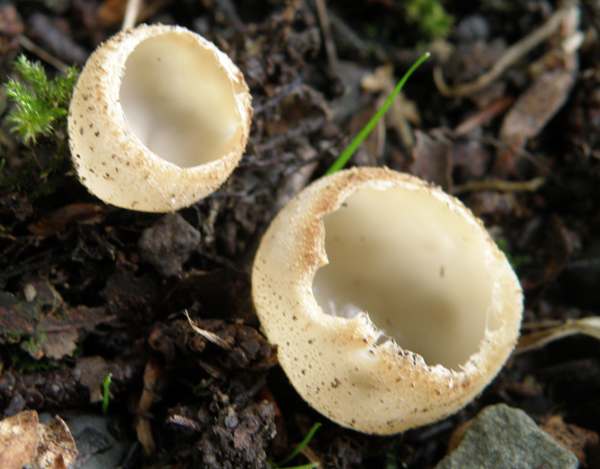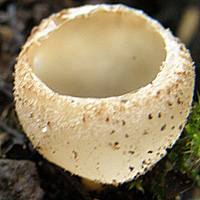Tarzetta cupularis (L.) Svrček - Toothed Cup
Phylum: Ascomycota - Class: Pezizomycetes - Order: Pezizales - Family: Pyrenomataceae
Distribution - Taxonomic History - Etymology - Identification - Culinary Notes - Reference Sources

This rather uncommon pezizoid fungus appears on woodland tracks and occasionally on woodchip mulch. The Toothed Cup is a neat, inedible little fungus and rarely jostles its neighbours for growing space.
Like so many of the cup fungi, identification is almost impossible without microscopic examination. Tarzetta scotica is considered by some authorities to be a synonym, while others - Class it as a separate species. Viewed at a macroscopic level the two are virtually identical.
Distribution
Uncommon but widespread across Britain and Ireland, Tarzetta cupularis is found also throughout mainland Europe and in parts of North America.
Taxonomic history
When in 1753 Carl Linnaeus described this ascomycete fungus he gave it the binomial scientific name Peziza cupularis. The currently-accepted scientific name dates from 1981, when Czech mycologist Mirko Svrček (b. 1925) transferred this species to the genus Tarzetta.
Synonyms of Tarzetta cupularis include Peziza cupularis L., Pustularia cupularis (L.) Fuckel, and Geopyxis cupularis (L.) Sacc.
Etymology
Tarzetta, the generic name, is almost certainly a corruption of the Italian noun Tazzeta meaning 'little cup' - a reference to the diminutive size and general shape of fungi in this genus. (Tazza in Italian means cup, and probably comes from the French noun Tasse which has the same meaning.) The specific epithet cupularis is derived from Latin and means 'like a little cup'.
Identification guide
 |
FruitbodyThe fruitbody comprises a fairly deep cup 0.6 to 2cm across often with a short buried stem; the inner surface is smooth, light ochre while the outer surface is also cream to light ochre but downy; its margin is incurved and becomes finely toothed when fully mature. The whitish stem is up to 1cm long and 2-4mm in diameter. |
Asci8-spored. SporesEllipsoidal, smooth, 20-22 x 13-15µm; hyaline, with two large oil drops. Spore printWhite. |
|
Odour/taste |
Not distinctive. |
Habitat & Ecological role |
On woodland tracks and occasionally on sawdust heaps and woodchip mulch. |
Season |
June to November in Britain and Ireland. |
Similar species |
There are at least 100 Peziza species and most are various shades of fawn or brown. Definite identification is rarely possible without microscopic examination. |
Culinary notes
Like the majority of the ascomycete cup fungi, this species is inedible.
Reference Sources
Fascinated by Fungi, 2nd Edition, Pat O'Reilly 2016, reprinted by Coch-y-bonddu Books in 2022.
Dennis, R.W.G. (1981). British Ascomycetes; Lubrecht & Cramer; ISBN: 3768205525.
Breitenbach, J. & Kränzlin, F. (1984). Fungi of Switzerland. Volume 1: Ascomycetes. Verlag Mykologia: Luzern, Switzerland.
Medardi, G. (2006). Ascomiceti d'Italia. Centro Studi Micologici: Trento.
Dictionary of the Fungi; Paul M. Kirk, Paul F. Cannon, David W. Minter and J. A. Stalpers; CABI, 2008
Taxonomic history and synonym information on these pages is drawn from many sources but in particular from the British Mycological Society's GB Checklist of Fungi.
Fascinated by Fungi. Back by popular demand, Pat O'Reilly's best-selling 450-page hardback book is available now. The latest second edition was republished with a sparkling new cover design in September 2022 by Coch-y-Bonddu Books. Full details and copies are available from the publisher's online bookshop...

